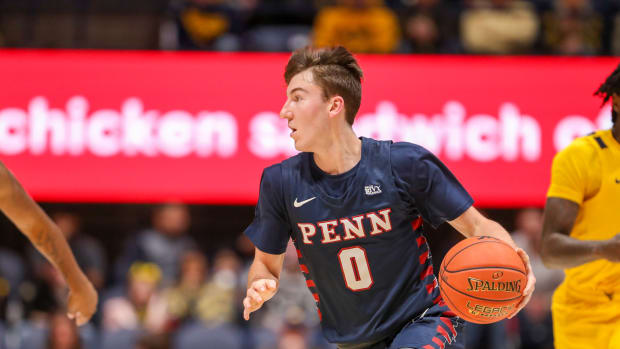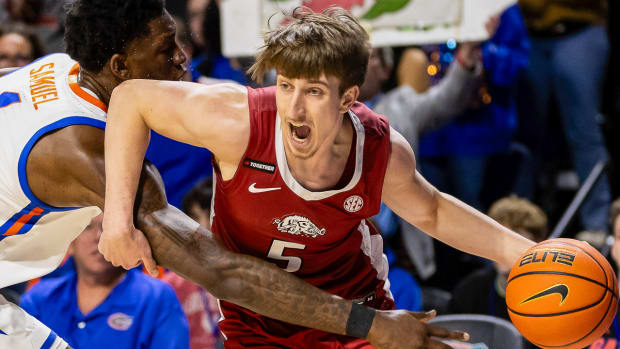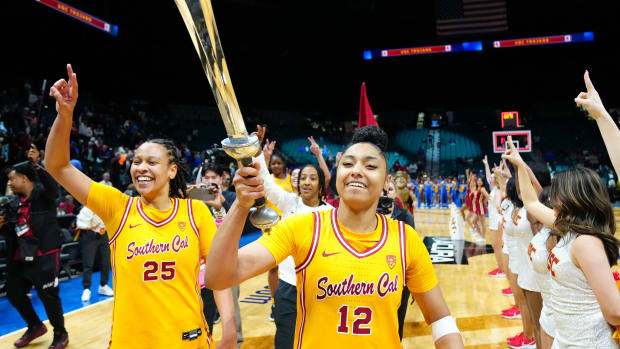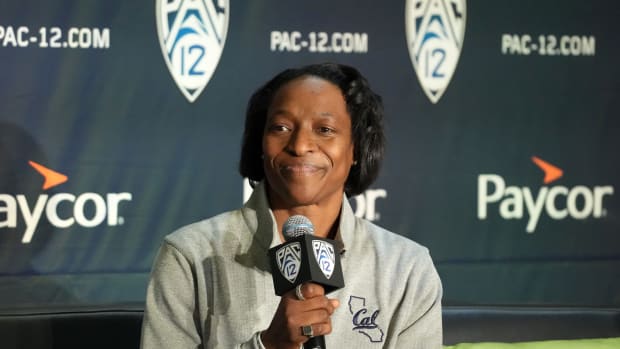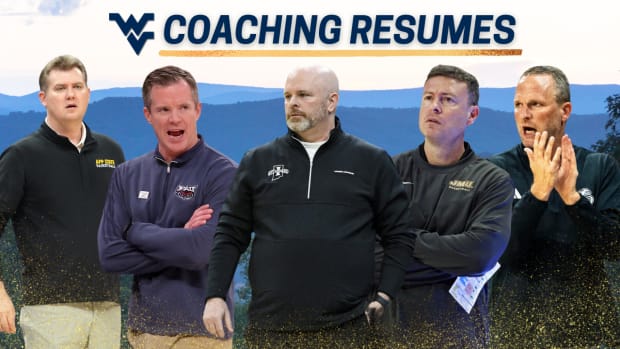Big 12 Offseason Report: Power Rankings and Burning Questions for 2019–20
As the midpoint of college basketball’s offseason approaches, it’s time to check in on every major conference. Every team in the country has questions at this point of the summer, some more pressing than others. So in addition to power ranking each league, we’ll be asking some burning questions about the conference that won’t be answered until tip-off. With the AAC and ACC down, next up is the Big 12.
Big 12 Summer Power Rankings
1. Kansas: Dedric Lawson’s departure leaves a scoring void, but the return of Udoka Azubuike keeps the Jayhawks firmly in the national title picture. Another year in Lawrence should do wonders for Devon Dotson as Bill Self seeks his second national title.
2. Texas Tech: A top-two finish in the conference would be an accomplishment for Beard and Co. Jarrett Culver, Matt Mooney and Tarik Owens have all left Lubbock, increasing the burden on sharpshooter Davide Moretti. The cupboards aren’t completely bare in Lubbock, though. The Red Raiders added a pair of four-star swingmen: Texas native Jahmius Ramsey and IMG Academy product Terrence Shannon.
3. Baylor: Expectations are high in Year 17 of the Scott Drew era. The Bears are long and athletic, and among the top defense teams in the conference. Paired with Big 12 Player of the Year candidate Tristan Clark, Baylor is a major threat to Kansas and Tech atop the conference.
4. Iowa State: Few teams in the conference enter 2019-20 with more question marks than the Cyclones. Iowa State needs to replace its top three scorers as well as veteran mainstay Nick Weiler-Babb, and will be relying on a cast of largely unknowns. Steve Prohm should work the most of his misshapen roster, though, and junior guard Tyrese Haliburton is a potential first-round pick. Senior forward Michael Jacobson also returns, leaving the Cyclones in line for a seventh tournament appearance in the last eight seasons.
5. Oklahoma State: The Cowboys return all five starters from last year’s team and are gaining an additional dose of talent. UMass forward Jonathan Laurent should add some major perimeter firepower after shooting 46.7% from three last year, as should 6’10” Dutch center Hidde Roessink. The 2019-20 campaign could mark a stepping stone year for the Cowboys before the potential arrival of Cade Cunningham, the No. 3 recruit in the 2020 class.
6. Texas: The good vibes of last season’s NIT run will quickly fade if the Longhorns fall toward the bottom of the Big 12 in 2019-20. Shaka Smart has yet to win a tournament game in four seasons with the Longhorns, missing the big dance in 2017 and 2019. Smart isn’t on the hot seat necessarily, but grumblings for his dismissal will continue to rise with another disappointing year. Keep an eye on point guard Matt Coleman; the junior point guard will dictate the Longhorns’ success in year five of the Smart era.
7. Kansas State: Restocking the cupboards is a tall task for Bruce Weber’s crew in 2019-20. Guards Barry Brown and Kamau Stokes have graduated, as has Dean Wade—the heart of the Wildcats’ offense over the last two seasons. Xavier Sneed could earn All-Big 12 honors in his senior season with an increased scoring burden.
8. Oklahoma: Junior forward Brady Manek should lead the Sooners following Christian James’s graduation, and top-50 recruit De’Vion Harmon could make an immediate impact in the backcourt. Lon Kruger is one of the nation’s most consistent coaches. He should steady the ship despite a slate of new faces.
9. West Virginia: The Mountaineers once again face an uphill climb after a disastrous 2018-19, needing to replace big men Esa Ahmad and Sagaba Konate as well as point guard James Bolden. Jordan McCabe may need to take a major leap for West Virginia to sniff the NCAA tournament.
10. TCU: Jamie Dixon faces a tough task replacing a number of departures, headlined by forward Kouat Noi’s decision to play overseas. Kendric Davis and Jaylen Fisher also transferred in 2019, leaving a weak roster in what should be a competitive conference. TCU enters the season outside the tournament conversation.
Burning Questions
Will Azubuike swing the conference?
Udoka Azubuike was cleared for basketball activities in June after undergoing season-ending hand surgery in January, returning to the floor as a serious candidate for Big 12 Player of the Year honors. The Jayhawks’ imposing center was a critical piece to Kansas’s 2018 Final Four squad, anchoring the backline surrounded by a string of shooters. Azubuike will play a similar role if Kansas reaches Atlanta in April 2020.
Azubuike won’t be alone in the paint. Forward Silvio De Sousa was cleared to play in March, as he will be returning to the floor this fall for the first time since March 2018. De Sousa remains a raw offensive presence, but paired with Azubuike, Kansas boasts one of the nation’s most fearsome frontlines.
Will grad transfers keep Texas Tech afloat?
Beard faces a slew of departures from his program after falling just short of a miraculous run to the championship. Yet, while he’s unlikely to reach the title game in 2019-20, Texas Tech can still win the Big 12. Its deep pool of transfers could swing the conference.
Chris Clarke headlines the additions for Texas Tech. A 6’6” swingman from Virginia Tech, Clarke is a physical forward and an impactful defensive presence, adept at crashing the glass and earning extra possessions. T.J. Holyfield will come to Lubbock on the grad transfer market from Stephen F. Austin, adding another interior presence to replace Tariq Owens and Norense Odiase. Texas Tech may struggle to score in 2019-20, but its defense should remain among the best in the nation.
Will Texas capitalize on another top center?
The Longhorns have landed plenty of talent in Smart’s tenure. Thirteen four- or five-star prospects came to Austin from 2016-18, including Mo Bamba, Jarrett Allen and Jaxson Hayes. But as Texas’s guards struggle, so do the burnt orange. None of the Longhorns’ aforementioned centers were playmakers at the collegiate level. Without a guard to feed them (Kerwin Roach has some major culpability here), their scoring was limited. Can the newest big change the equation?
Enter Will Baker. A seven-footer from Westlake high school in Austin, Baker is a nimble five, able to stretch the floor past the foul line and score in the midrange. He’s not a similar pro prospect to Bamba or Allen entering the 40 Acres, but he could very well make a larger long-term impact. If Baker shines and Coleman grows, Texas could win its first tournament game since 2014.
Can Tshiebwe reverse course in Morgantown?
Derek Culver is the Mountaineers’ top returning scorer after a quartet of key departures from Bob Huggins’s program. And he won’t be able to lift West Virginia out of the conference cellar alone. Freshman Oscar Tshiebwe remains the most likely candidate to bring the Mountaineers back to relevance.
A 6’9”, 250-pound center, Tshiebwe comes to Morgantown as the No. 30 prospect in the nation and the top recruit in Pennsylvania. He’s a furious rebounder and agile post presence, a capable finisher compared to most freshmen centers. The best Huggins teams clean the glass with abandon. Perhaps Tshiebwe can set the tone and reverse West Virginia’s fortunes, but a true rebound likely remains a year away.
Who will win Big 12 Player of the Year?
Azubuike is certainly among the favorites, as is Dotson if he takes a leap in his sophomore season. The Jayhawks could certainly cannibalize themselves in the race, leaving the door open for a host of candidates throughout the conference. A top-three finish for Iowa State could give Haliburton the honor; ditto for Clark in Waco. The honor may stay in Lubbock, though. A hot year for Moretti could mark Texas Tech’s second straight Big 12 Player of the Year, propelling the Red Raiders back into the Final Four conversation.
